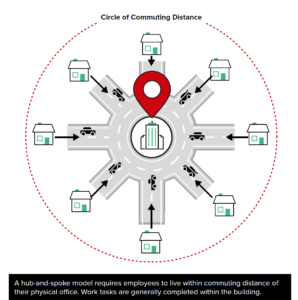It’s Time To Discard Outdated Conceptions Of The Office
Many employees and employers are locked in perceived and actual conflict over the role of the office. They disagree over its purpose, its value, and how often to visit. The loosening of pandemic restrictions encouraged leaders to bring employees back into offices, but the transition hasn’t been smooth.
Some firms — notably, several on Wall Street — take a hardline approach. They’re among the 34% of organizations trying to return to the pre-pandemic office model. JPMorgan derided remote collaboration as “management by Hollywood Squares” and demanded a return to five full days in the office. The company enforced this policy by monitoring ID badge swipes and Zoom usage. Goldman Sachs has been pushing for office return since February 2021 and ordered an autumn return to office, too. But the specter of employee attrition has loomed over these efforts.
Even the 51% of firms pursuing a hybrid strategy (which includes both office and remote work) have struggled to win over employees. Apple’s new hybrid policy of three office days per week looks unpopular as employees circulate a petition advocating for more flexibility.
Some Leaders Need To Update Their Idea Of The Office
For our new report The Future Of The Office, we interviewed 46 companies and surveyed 722 employees to understand the changing nature of the office, what it will look like in the future, and how leaders should create strategies as a result. We found:
- Employees’ preferences have shifted. Forrester’s workforce data reveals that 68% of workers say they hope they can work from home more often. This number stayed steady in 2022 and 2021, indicating a stable preference. But most employees don’t want fully remote work; they prefer hybrid with flexible parameters.
- The 1950s called, and they want their office model back. The old hub-and-spoke office model assumes that work will be done on-site and that employees will live within commuting distance. It’s limiting. Talent markets are global, but the hub-and-spoke model restricts hiring to a single geography or else requires opening satellite offices. It’s also costly, both in terms of office space and the carbon costs of commuting.

What’s Next: The Anywhere-Office
Instead of thinking of physical offices and home offices as in conflict, innovative leaders and their most adaptive employees think of them both as part of a single networked entity, the anywhere-office. This model moves away from the outdated hub-and-spoke hierarchy, instead making every node on the network an equal participant in office life — and those nodes can be anywhere. The office headquarters and satellite offices exist to provide resources to employees, but they don’t act as bottlenecks to the growth of the organization. This model represents a true reinvention of the office:
- The office isn’t just a place anymore. It’s a network of locations, practices, technologies, and people that empowers employees to be successful and productive while honoring their individual needs.
- The physical office is a collaboration-focused resource. The physical office offers resources in the form of technology, space, and, most importantly, other people. It’s a venue for collaboration beyond Zoom, used for training, culture building, brainstorming, and decision-making during punctuated, planned in-person moments. It’s not so much the place where work gets done as the place where work gets done with other people.
Learn More — And Attend Our Technology & Innovation Forum
To learn more, we invite Forrester clients to read our major new report, The Future Of The Office.
On September 29, we will release a sequel report, “The Messy Middle Of Hybrid,” specifically concerning hybrid work. We’ll also be presenting at Forrester’s Technology & Innovation Forum — a hybrid event, of course — in Austin on September 29.
J. P. Gownder is a vice president and principal analyst on Forrester’s Future of Work team.
